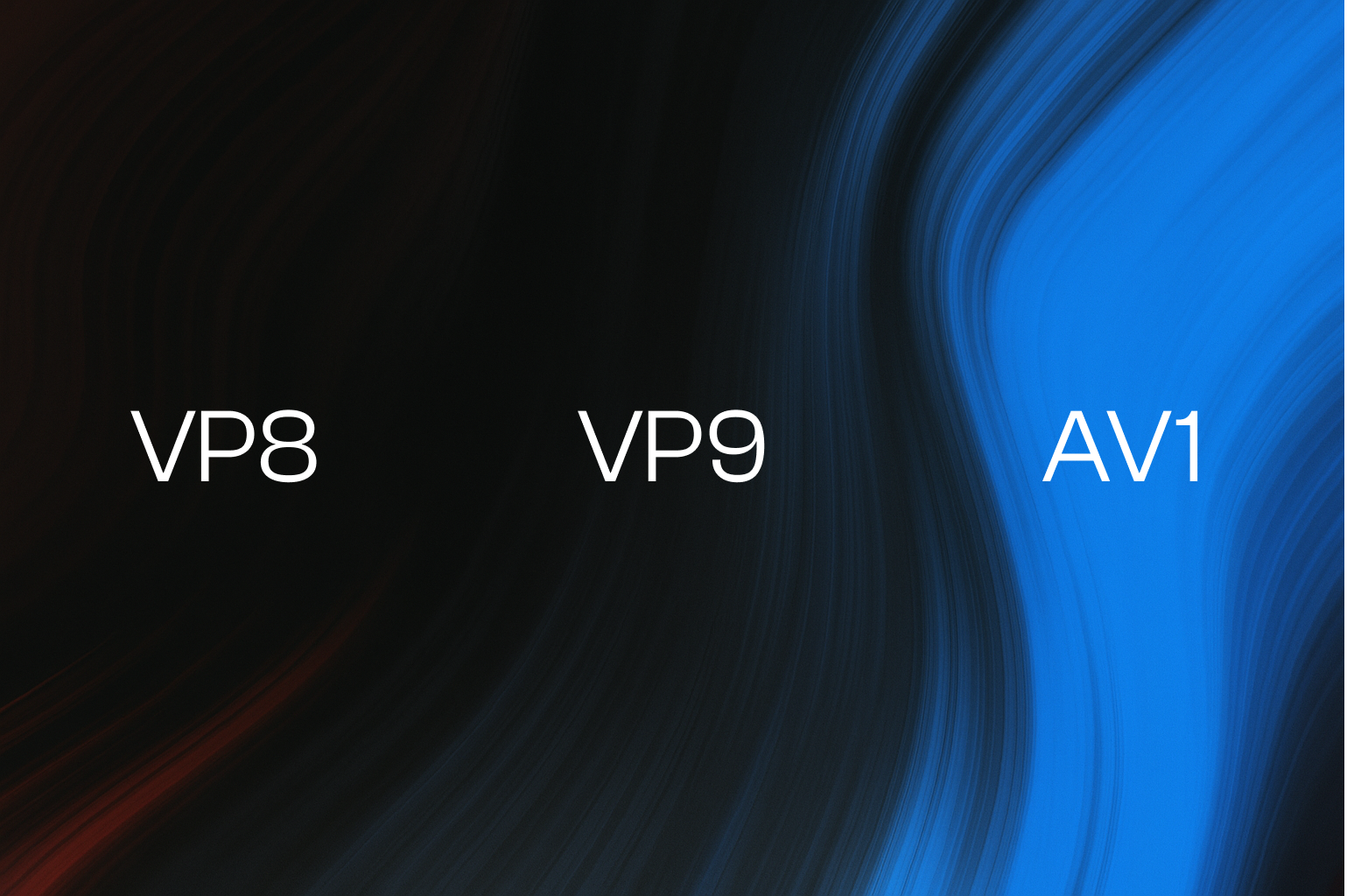We covered how VP9 compares to H.264 and H.265 in our previous blog. In this one, we’ll look at which codec comes out on top in the fight between VP8 vs VP9 vs AV1. You’ll learn how they differ in compression efficiency, encoding performance, HDR support, CPU consumption, browser support, licensing, bandwidth savings, supported streaming… Continue reading AV1 vs VP9 vs VP8: Codec Comparison Guide 2025
We covered how VP9 compares to H.264 and H.265 in our previous blog. In this one, we’ll look at which codec comes out on top in the fight between VP8 vs VP9 vs AV1. You’ll learn how they differ in compression efficiency, encoding performance, HDR support, CPU consumption, browser support, licensing, bandwidth savings, supported streaming protocols, and development readiness. We’ll also cover what the next five years may hold for these codecs. If you’d rather skip ahead to the “How to Choose a Codec” or “How to Migrate” section, check the table of contents below.
What is a Video Codec?
A video codec is a software or hardware process that compresses or decompresses digital video. Video codecs are employed to reduce the size of video media to take-up less storage when archived and lower bitrates to stream; both yielding cost savings. When you watch a video online, the codec compresses it for sending and then decompresses it for viewing. Codecs are used in streaming, video calls, and everyday video playback.
Why Video Compression Matters?
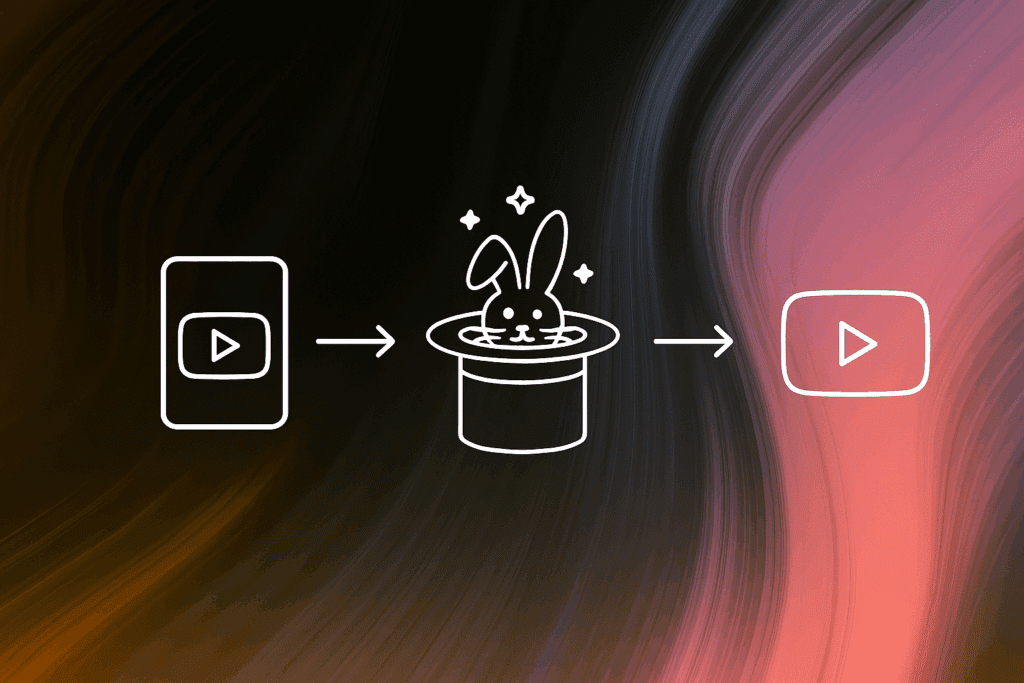
Illustration of the video compression process.
Video compression is the process of reducing the size of raw or encoded video data by removing redundant or unnecessary information, while preserving as much of the original visual fidelity as possible. It enables large video files to be transmitted, stored, and played efficiently over networks by encoding frames more compactly.
In modern streaming technology, video compression is crucial because it strikes the balance between video quality and bandwidth use. Without compression, high-resolution streams would demand enormous amounts of bandwidth, likely causing buffering and high costs for both providers and users. For example, switching from H.264 to HEVC can cut required bandwidth nearly in half for the same perceived quality.
Efficient compression lets platforms deliver smooth, high-quality video even over constrained networks, reduce delivery and storage costs, and scale to global audiences.
Google’s Open-Source Codec Family
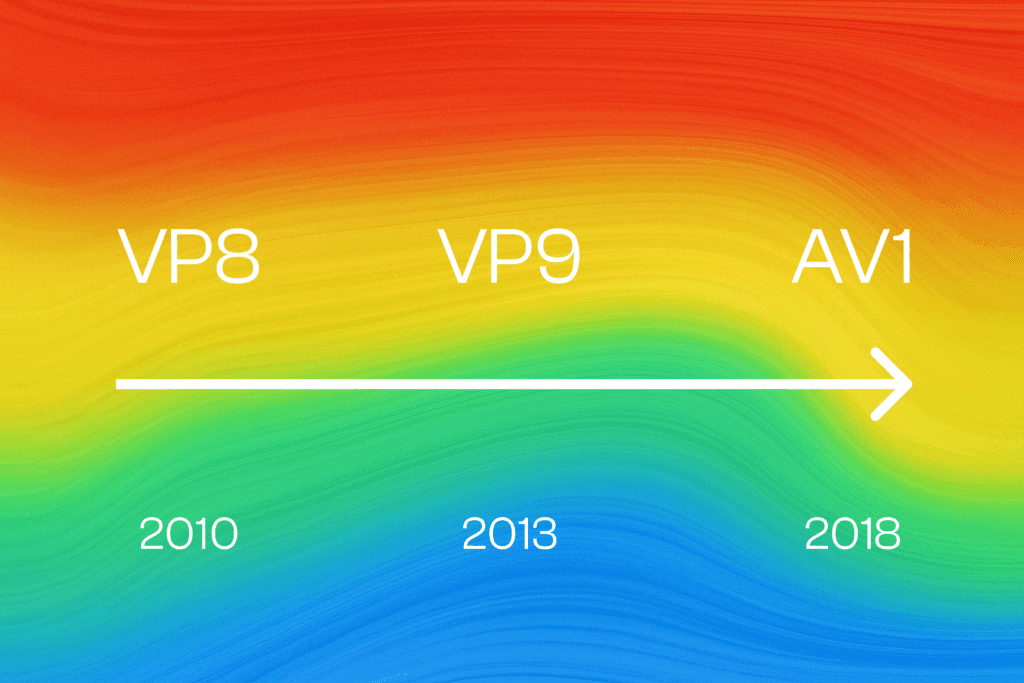
Evolution of Google’s open-source codec family.
Google’s open-source codec family (VP8, VP9, and AV1) represents a complete evolution of video compression technology over the past decade. Understanding the progression and differences between these codecs is crucial for streaming platforms, content creators, and developers making infrastructure decisions.
This codec family emerged from Google’s acquisition of On2 Technologies in 2010 and the subsequent Alliance for Open Media’s mission to create royalty-free, open-source video standards. From VP8’s foundational work to AV1’s cutting-edge compression, each codec has played a vital role in democratizing high-quality video streaming. That’s why we will review these codecs in historical order.
VP8 codec
VP8 codec is a royalty-free video compression standard that enables efficient delivery of high-quality video while minimizing bandwidth requirements. It is widely used in modern streaming and real-time video applications because it provides a good balance between compression efficiency and playback performance.
How It Works
VP8 compresses video by removing redundant information within and between frames to reduce file sizes while maintaining visual quality. It was engineered to simplify decoding compared to earlier formats, making it more practical for web and real-time uses. Learn more about this codec in Google’s official VP8 Data Format and Decoding Guide.
Some of the key advancements include:
- Royalty-Free Licensing: VP8 was one of the first modern codecs offered without licensing fees, making it accessible for developers and platforms without legal or financial barriers.
- Efficient Compression: VP8 delivers a solid balance of video quality and file size, reducing bandwidth consumption while maintaining acceptable visual fidelity for HD streaming.
- Web Integration: Designed with web video in mind, VP8 became the core codec for the WebM container format, ensuring broad support across browsers and online platforms.
- Real-Time Suitability: With relatively low computational complexity, VP8 is well-suited for real-time applications like video conferencing, where both quality and low latency are critical.
- Error Resilience: VP8 introduced techniques to handle transmission errors more gracefully, improving reliability in streaming environments with unstable network conditions.
What is VP9?
VP9 codec is a royalty-free, open-source video coding standard developed by Google. It emerged as a free competitor to closed-source codecs like H.265. It was designed to meet the demands of modern video content and significantly improve coding efficiency over its predecessor, VP8.
How It Works
Like H.265, VP9 uses larger block structures (up to 64×64 pixels) compared to H.264’s 16×16 macroblocks, enabling more efficient compression. It employs advanced intra-frame prediction, motion compensation, and entropy coding to reduce redundancy. These techniques allow VP9 to achieve better quality than H.264 at the same bitrate while remaining royalty-free for developers.
VP9 introduced several significant technical improvements over its predecessor VP8, aimed at increasing compression efficiency, enhancing video quality, and optimizing performance for a wide range of devices and network conditions.
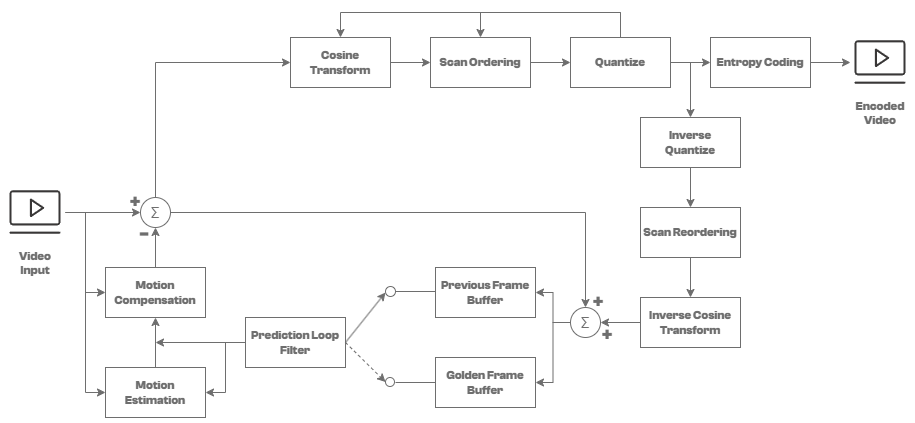
VP9 Encode Process Diagram.
Some of the key advancements include:
- Improved Compression Efficiency: VP9 offers better compression than VP8, allowing for reduced file sizes without sacrificing video quality and detail. This is particularly beneficial for 4K and higher resolutions, where bandwidth efficiency is crucial.
- Higher Resolution Support: VP9 supports ultra-high-definition video content, enabling more efficient streaming of 4K and higher resolution videos than VP8. This makes it well-suited for platforms that demand high-quality video experiences.
- Adaptive Block Size: Unlike VP8, which uses a fixed block size, VP9 can adaptively choose from a range of block sizes (from 4×4 to 64×64 pixels) for more efficient coding. This flexibility allows VP9 to better handle a variety of content types and details within a video frame.
- Tile-based Parallel Processing: VP9 introduces tiling, which divides the video frame into smaller, independent regions that can be processed in parallel. This feature improves encoding and decoding performance, especially on multi-core processors, and facilitates error resilience in streamed content.
- Enhanced Prediction Modes: VP9 includes more advanced prediction modes for both intra-frame and inter-frame (motion) predictions. These improvements help in reducing redundancy and achieving higher compression ratios by better predicting pixel values within frames.
- Asymmetric Motion Partitions: VP9 allows for more complex motion vectors with its asymmetric motion partitioning feature, enabling more precise motion estimation and compensation. This leads to better handling of motion in videos, improving the quality of fast-moving scenes.
- Multi-threading Support: VP9 is designed to take better advantage of multi-threading capabilities in modern processors, enhancing the speed and efficiency of video encoding and decoding processes.
- Improved Loop Filters: VP9 includes enhanced loop filtering techniques, which help in reducing blockiness and other compression artifacts, resulting in smoother and clearer video playback.
This leap in efficiency was crucial for accommodating the burgeoning trend of ultra HD (UHD) content on platforms like YouTube. With 4K video rapidly becoming the standard for content consumption, the need for a codec that could provide high-quality video without the hefty bandwidth requirements of previous standards was more pressing than ever.
What is AV1?
AV1 codec is a next-generation, royalty-free video compression standard developed by the Alliance for Open Media (AOMedia). It was designed to deliver significantly better compression efficiency than older codecs like VP9 and H.265 also called HEVC, while maintaining high video quality across a wide range of resolutions and devices. AV1 reduces bandwidth consumption, making it ideal for modern streaming platforms, 4K and 8K video, and emerging immersive applications such as VR and AR.
How It Works
AV1 achieves superior compression by combining advanced prediction techniques, flexible partitioning, and enhanced filtering to reduce redundancy and improve visual fidelity. It is optimized for both streaming efficiency and playback performance, with hardware acceleration increasingly available in modern devices.
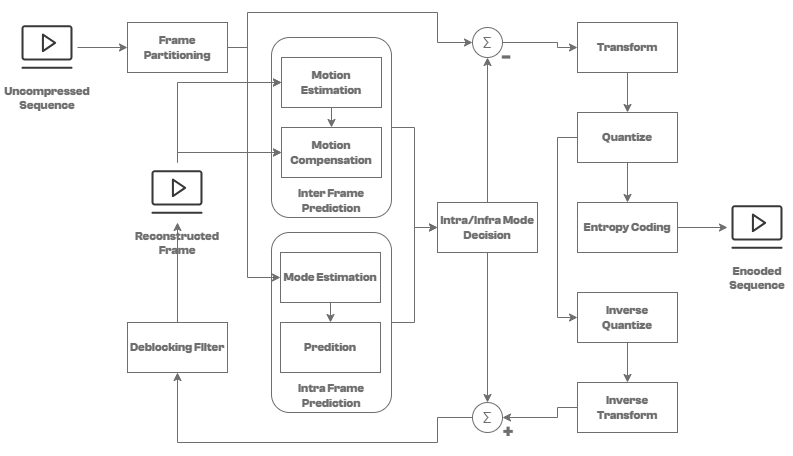
AV1 Encode Process Diagram.
Some of the key advancements include:
- Superior Compression Efficiency: AV1 reduces file sizes by 30–50% compared to VP9 and HEVC at equivalent video quality, lowering bandwidth requirements for high-resolution streaming.
- Scalable Resolution Support: AV1 supports everything from mobile video up to 8K and beyond, making it versatile for a wide range of use cases.
- Advanced Prediction Modes: AV1 improves intra-frame and inter-frame predictions, resulting in more accurate motion estimation and smoother playback.
- Flexible Block Partitioning: AV1 allows for dynamic block sizes down to 4×4 pixels and up to 128×128 pixels, adapting better to content complexity than previous codecs.
- Enhanced Parallel Processing: AV1 supports multi-threading and tiling, enabling faster encoding and decoding on multi-core systems.
- Improved Loop Filtering: Features like Constrained Directional Enhancement Filter (CDEF) and Loop Restoration Filter reduce compression artifacts and improve visual quality.
10 Points of Comparison for VP8 vs VP9 vs AV1
| Point of Comparison | VP8 | VP9 | AV1 | Winner |
| Release Year | 2010 | 2013 | 2018 | AV1 |
| Compression vs H.264 | Comparable | ~50% better | ~50% better than VP9 | AV1 |
| Encoding Quality | 1080p optimized | 4K | 4K/8K capable | AV1 |
| Encoding Time | Fast | Medium | Slow (improving) | VP8 |
| HDR Support | None | Basic | Advanced | AV1 |
| CPU Consumption | Low | Medium | High | VP9 |
| Browser Support | Universal (legacy) | Universal | Growing rapidly | VP9 |
| Bandwidth Savings | Medium vs H.264, but quality is degraded | Good compression, but less efficient than H.265 | Very good compression and low bandwidth. CPU bears the impact for the savings | AV1 |
| Licensing and Accessibility | Open-source, royalty-free | Open-source, royalty-free | Open-source, royalty-free | – |
| Live Streaming Ready | Yes | Yes | Developing | VP9 |
| Supported Streaming Protocols | WebRTC, Enhanced RTMP, and RTSP. YouTube previously supported it prior to AV1 being added. | Supports WebRTC, MPEG-DASH, YouTube streaming; limited RTMP/RTSP usage | WebRTC, Enhanced RTMP, YouTube, HLS, DASH. | AV1 |
Codec Comparison Table: VP8 vs VP9 vs AV1.
1. Release year
- VP8: The Foundation (2010)
VP8 was Google’s first major foray into open-source video compression after acquiring On2 Technologies. Released in 2010 and subsequently open-sourced, VP8 was designed to compete directly with H.264 while remaining completely royalty-free. It became the foundation for WebM container format and was widely adopted for web-based video applications.
- VP9: The Breakthrough (2013)
VP9, released by Google in 2013, represented a significant leap forward in compression efficiency. It was designed as an open-source alternative to the proprietary H.265/HEVC codec and offered substantial improvements over both VP8 and H.264. VP9 became widely adopted across YouTube, Netflix, and other major streaming platforms.
- AV1: The Future (2018)
AV1, finalized in 2018, builds upon VP9’s foundation while incorporating advanced compression techniques developed by the Alliance for Open Media. This consortium includes industry giants like Google, Mozilla, Netflix, Amazon, and Apple, ensuring broad industry support for the standard.
Winner: AV1.
2. Compression Efficiency
- VP8 Characteristics:
– Provided compression efficiency comparable to H.264 baseline.
– Used 4×4 and 16×16 block-based transform coding.
– Employed simple loop filtering and basic entropy coding.
– Optimized primarily for web-based 720p/1080p content.
- VP9 Improvements:
– Delivered approximately 50% better compression than VP8.
– Introduced variable block sizes from 4×4 to 64×64 pixels.
– Advanced loop filtering and improved motion prediction.
– Better handling of high-resolution content up to 4K.
- AV1 Advances:
– Achieves 30-50% better compression efficiency than VP9.
– Advanced block partitioning with up to 128×128 superblocks.
– Sophisticated intra-prediction with 56 directional modes.
– Enhanced entropy coding with symbol-adaptive arithmetic coding.
– Optimized for high-resolution streaming, supporting 4K and 8K video.
Winner: AV1.
3. Encoding Performance
- VP8 Performance:
– Fast encoding suitable for real-time applications.
– Low computational requirements.
– Mature, optimized encoder implementations. - VP9 Performance:
– Moderate encoding complexity, 2-3x slower than VP8.
– Well-optimized implementations available (libvpx).
– Good balance of quality and encoding speed.
- AV1 Performance:
– Significantly higher computational complexity (5-10x slower than VP9).
– Rapidly improving software optimizations.
– Quality gains and overall bandwidth savings often justify computational cost for many applications.
Winner: VP8.
4. Color Depth and HDR Support
- VP8: No native HDR support. VP8 is limited to 8-bit color depth and lacks HDR metadata handling.
- VP9: Supports HDR with 10-bit and 12-bit color depth and can carry HDR10 and HLG metadata. VP9 Profile 2 specifically enables HDR playback.
- AV1: Full HDR support with 10-bit and 12-bit color depth, wide color gamut (BT.2020), HDR10, HDR10+, and Dolby Vision. AV1 was designed with HDR as a baseline requirement.
Winner: AV1.
5. CPU Consumption
- VP8: Lightweight on CPU during encoding and decoding, thanks to its simpler tools and 8-bit, baseline design. (No strong source explicitly quantifying, but its use in real-time apps like early WebRTC is consistent with low CPU overhead.)
- VP9: While most mobile devices support VP9, most other systems do not. Without direct hardware support, the VP9 encoding process will peg the CPU, consuming a large amount of resources, decreasing battery life, and potentially increasing latency.
- AV1: AV1 encoding and software decoding are significantly more CPU intensive than VP9, making it more suitable for offline or server-side encoding rather than real-time on devices lacking hardware support.
Winner: VP8.
6. Browser and Device Support
| Browser/Platform | VP8 Support | VP9 Support | AV1 Support |
|---|---|---|---|
| Chrome | ✅ Since 2010 | ✅ Since 2014 | ✅ Since 2018 |
| Firefox | ✅ Since 2012 | ✅ Since 2014 | ✅ Since 2019 |
| Safari | ✅ Since 2013 | ✅ Since 2020 | ✅ Since 2021 |
| Edge | ✅ Full | ✅ Full | ✅ Since 2019 |
| Android | ✅ Native | ✅ Native | ⚠️ Android 10+ |
| iOS | ✅ Since iOS 7 | ✅ Since iOS 14 | ⚠️ iOS 14+ |
| Smart TVs | ✅ Legacy support | ✅ Widespread | 🔄 2020+ models |
VP8, VP9, and AV1 browser and device support comparison table.
- VP8: Supported in Chrome, Firefox, Edge, and Safari (for WebRTC). Android supports VP8 playback in WebM since version 2.3. On iOS, VP8 is available only through WebRTC, not for native video playback. Limited support also exists in some legacy smart TVs.
- VP9: Supported in Chrome, Firefox, Edge, and Safari (starting with version 14 on macOS Big Sur / iOS 14). Android supports VP9 playback natively (since Android 4.4 KitKat). Hardware decoding is widely available, and many smart TVs support VP9 for 4K streaming (especially YouTube and Netflix apps).
- AV1: Supported in Chrome, Firefox, Edge, and recent Safari builds (macOS 16 / iOS 16+) when hardware decoding is present. AV1 playback is supported on Android 10+ devices with hardware decoders, and smart TV manufacturers such as Samsung, LG, and Sony include AV1 support in models released from 2020 onward.
Winner: VP9.
7. Bandwidth Savings
- VP8: Provides moderate bandwidth savings compared to older codecs like H.264, but is less efficient than newer options. It reduces file sizes while maintaining acceptable quality, making it practical for basic HD streaming where bandwidth demands are moderate.
- VP9: Offers significantly better bandwidth efficiency than VP8, reducing data use by around 30–50% at the same visual quality. This makes VP9 well suited for high-definition and 4K streaming, allowing smoother playback and reduced buffering on lower-bandwidth connections.
- AV1: Delivers the strongest bandwidth savings of the three codecs, with compression efficiency improvements of 30–50% over VP9. This efficiency makes AV1 ideal for 4K, 8K, and HDR content, as it provides higher video quality at lower bitrates, helping streaming services scale while reducing delivery costs.
Winner: AV1.
8. Licensing and Accessibility
- VP8: A royalty-free codec provided as open source, making it accessible for developers without licensing costs.
- VP9: Google offers VP9 as an open-source codec, available royalty-free to encourage widespread adoption and integration, presenting a more accessible option for developers and content providers looking to implement high-efficiency video coding without the burden of licensing fees. Having a free high-performance codec for use in Google Chrome was likely one of the main reasons for Google to offer it as open source.
- AV1: Backed by the Alliance for Open Media, AV1 is open source and royalty-free. It was designed to be an industry-standard codec that removes licensing barriers for modern video applications, giving developers and providers an advanced option for delivering high-quality, bandwidth-efficient video without additional costs.
9. Live Streaming Ready
- VP8: Fully supported for live streaming and real-time communication. It remains ready for use but is increasingly considered a legacy option as newer codecs provide greater efficiency and features.
- VP9: Ready and actively used for live streaming today. It offers better efficiency than VP8 while maintaining real-time performance, making it a common choice for platforms that prioritize quality and bandwidth savings.
- AV1: Still developing in the live streaming space.
Winner: VP9.
10. Supported Streaming Protocols
Each codec supports different streaming protocols, which affects how easily they can be integrated into live video workflows.
- VP8 Codec: Supports WebRTC for real-time communication and is compatible with most HTML5 video playback workflows. It has limited adoption in modern adaptive streaming protocols and is rarely used with legacy options like RTMP or RTSP.
- VP9 Codec: VP9 supports WebRTC, MPEG-DASH, and YouTube streaming. It provides limited RTMP/RTSP usage.
- AV1 Codec: Supported in modern streaming workflows such as MPEG-DASH and HLS with CMAF packaging. AV1 integration into WebRTC is still developing, and support for RTSP is not available. Recently RTMP gained support for AV1 via Enhanced RTMP.
Winner: AV1.
What Codec To Choose Between VP8, VP9, and AV1?

How to Choose Between VP8, VP9, and AV1
- If you need broad compatibility with older devices and browsers, low computational costs, and a reliable fallback option for legacy hardware, choose VP8. It is cost-effective for basic applications but offers only moderate bandwidth efficiency.
- If you need a mainstream codec that balances performance and efficiency, integrates well with WebRTC, and benefits from widespread hardware acceleration, choose VP9. Significant bandwidth savings justify its higher encoding overhead, making it a proven ROI choice for medium- to large-scale deployments.
- If you need a future-ready solution for premium applications where maximum bandwidth efficiency and next-generation quality are critical, choose AV1. Although it carries a higher initial encoding cost, savings of 30–50% in bandwidth and growing hardware acceleration make it a strong long-term option for high-volume streaming.
For the most advanced streaming, use Red5 Pro. Its adaptive streaming capabilities automatically pick the best codec for each viewer based on device support and network conditions, so you can deliver the optimal experience without manual switching.
How to Migrate from VP8, VP9, or AV1

Steps to Transition from VP8, VP9, or AV1 codecs.
How to Migrate from VP8 to VP9 Codec
Organizations still using VP8 should prioritize VP9 migration:
- Immediate 40-50% bandwidth savings
- Maintained compatibility across devices
- Improved quality at equivalent bitrates
- Hardware acceleration benefits
Get in touch with us if you are interested.
How to Migrate from VP9 to AV1
Current VP9 implementations can gradually adopt AV1:
Phase 1: Assessment
- Evaluate current VP9 performance metrics.
- Test AV1 encoding with representative content.
- Assess target audience device capabilities.
- Calculate potential bandwidth cost savings.
Phase 2: Hybrid Deployment
- Implement AV1 for supported devices with VP9 fallback.
- Monitor quality and performance across both codecs.
- Optimize encoding parameters independently.
- Gradually increase AV1 usage as support expands.
Phase 3: Full AV1 Adoption
- Transition primary encoding to AV1 where supported.
- Maintain VP9 for legacy device compatibility.
- Implement intelligent codec selection algorithms.
- Monitor long-term performance and cost benefits.
AV1 codec support in Red5 Pro is coming early 2026. Get in touch with us today to join the waitlist and be among the first to try it.
Future Of Video Compression With VP8, VP9, And AV1
Current Market Position (2025)
- VP8 Codec: Legacy support and basic applications.
- VP9 Codec: Mainstream choice for most streaming applications.
- AV1 Codec: Premium applications and future-focused implementations.
- AV2 Codec: Next-generation codec AV2 is planned for release by the end of 2025 as the successor to AV1, designed to deliver even greater compression efficiency and to serve as a cornerstone of AOMedia’s future technology stack.
Short-term Strategy (2026 -2027)
- VP9 remains optimal for latency-critical live streaming.
- AV1 adoption accelerates for high-quality, bandwidth-sensitive applications. Hardware acceleration makes AV1 increasingly viable.
- Hybrid approaches maximize compatibility and efficiency.
- AV2 gains broader adoption as hardware vendors, browsers, and streaming platforms begin integrating decoding and encoding support.
Long-term Vision (2025 – 2030 years)
- AV1 becomes the dominant open-source codec.
- VP9 maintains relevance for specific compatibility requirements.
- VP8 relegated to legacy system support.
- AV2 becomes mainstream for high-end and large-scale deployments, especially as hardware acceleration matures across devices.
Conclusion
The evolution from VP8 through VP9 to AV1 represents more than a decade of advancement in open-source video compression technology. Each codec has served its purpose: VP8 established the foundation for royalty-free web video, VP9 delivered the quality and efficiency needed for mainstream adoption, and AV1 pushes the boundaries of what’s possible in video compression.
For organizations making codec decisions today, VP9 offers the best balance of quality, performance, and compatibility for most live streaming applications. AV1 provides a strategic path forward for premium applications and future-proofing, while VP8 remains relevant for legacy compatibility requirements.
Red5 Pro’s comprehensive support for all three codecs enables organizations to implement optimal strategies based on their specific requirements, audience capabilities, and quality objectives. Whether maintaining VP8 for legacy support, leveraging VP9 for mainstream applications, or pioneering with AV1 for next-generation streaming, Red5 Pro provides the infrastructure foundation for success.
The codec landscape continues evolving rapidly, but the VP codec family’s commitment to open standards and royalty-free licensing ensures these technologies will remain accessible and viable for organizations of all sizes in an increasingly video-centric digital world. To learn how the AV1 codec compares to H.264 and or to H.265, read our next blogs.
Try Red5 For Free
If your project requires the use of VP8 or VP9, start streaming for free with our advanced live streaming solutions: Red5 Cloud or Red5 Pro. AV1 codec support in Red5 Pro is coming early 2026. Get in touch with us today to join the waitlist and be among the first to try it.
🔥 Looking for a fully managed, globally distributed streaming PaaS solution? Sign up for Red5 Cloud today! No credit card required. Free 50 GB of streaming each month.
Looking for a server software designed for ultra-low latency streaming at scale? Start Red5 Pro 30-day trial today!
Not sure what solution would solve your streaming challenges best? Reach out to our team to discuss your case.
FAQ
Is VP8 better than VP9?
No. VP9 generally provides 30–50% better compression efficiency than VP8 at the same video quality. VP8 is lighter on CPU and still useful for legacy devices, but VP9 is the mainstream choice for modern streaming, offering higher quality at lower bitrates, broader adoption in browsers and smart TVs, and better support for high-definition content, including 4K video.
Is VP9 better than AV1?
AV1 is more advanced than VP9, delivering 30–50% greater compression efficiency, which means higher quality at lower bitrates. However, VP9 has the advantage of widespread hardware acceleration, making it more practical for live and latency-sensitive streaming. AV1 is still maturing in terms of hardware support, but it’s considered the long-term successor as ecosystem adoption grows.
What is the difference between Webm VP9 and AV1?
Both VP9 and AV1 can be wrapped in the WebM container, but AV1 is newer, offering significantly better compression and broader HDR support. VP9 is well-established and widely supported on browsers, Android, and smart TVs, while AV1 adoption is accelerating as hardware support improves. Essentially, AV1 saves more bandwidth at the same quality, but VP9 remains easier to deploy today.
Does AV1 have better quality?
Yes. At the same bitrate, AV1 achieves noticeably better visual quality than VP9 or VP8, thanks to more advanced prediction modes, partitioning, and filtering. This makes AV1 especially useful for bandwidth-sensitive applications, such as streaming high-resolution 4K or 8K content. The tradeoff is higher encoding complexity, though hardware and software optimizations are steadily improving performance.
Why is AV1 not popular?
AV1 adoption has been slower because encoding is significantly more CPU-intensive compared to VP9, making real-time use challenging. Additionally, hardware support for AV1 decoding and encoding has only recently become available in GPUs, CPUs, and smart TVs. As newer devices integrate AV1 acceleration and streaming platforms embrace its bandwidth savings, adoption is accelerating and expected to grow rapidly through 2026–2027.
Why is AV1 considered more future-proof than VP9?
AV1 is royalty-free, highly efficient, and designed with modern streaming demands in mind, including HDR, 8K video, and wide color gamut support. With backing from the Alliance for Open Media (AOMedia), it has strong industry momentum and hardware support is steadily expanding. These factors make AV1 more sustainable than VP9, which was optimized for an earlier generation of video delivery.
What Video Codec Does Youtube Use?
YouTube relies heavily on VP9 for most of its video streaming, especially for HD and 4K content, and increasingly uses AV1 for higher resolutions and premium features. The choice of codec depends on device capabilities and network conditions, with adaptive streaming ensuring the best format is delivered to each viewer.
Who Is Leading Standardization For Video-Codecs?
The Alliance for Open Media (AOMedia) leads the standardization of open-source codecs like VP9 and AV1, supported by major companies including Google, Netflix, Microsoft, Amazon, and Intel. For traditional MPEG codecs like H.264 and H.265, standardization is led by ISO/IEC MPEG and ITU-T VCEG. These bodies set specifications that shape global video compression standards.
When is AV2 codec being released?
The Alliance for Open Media has announced that AV2, the successor to AV1, is planned for release by the end of 2025. Broader adoption is expected in 2026–2027 as hardware support becomes available and platforms begin integrating it into production workflows. AV2 is expected to deliver even greater compression efficiency and new features for next-generation streaming.
The Red5 Team brings together software, DevOps, and quality assurance engineers, project managers, support experts, sales managers, and marketers with deep experience in live video, audio, and data streaming. Since 2005, the team has built solutions used by startups, global enterprises, and developers worldwide to power interactive real-time experiences. Beyond core streaming technology, the Red5 Team shares insights on industry trends, best practices, and product updates to help organizations innovate and scale with confidence.
